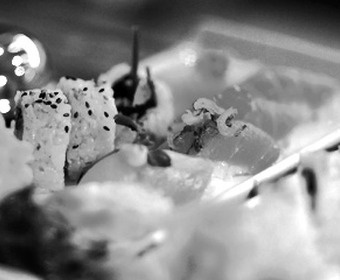
Other ways of cooking fish
- The perfect temperature control with sous vide
- Ask your fishmonger about fish for sushi
- Balance the flavors of cured, smoked, pickled fish
- Slice thin slices when semi-frozen
- Don’t cure lean fish
Fish protein is delicate, which means it’s also receptive to cooking in lots of different ways. With the right handling, it’s also delicious without any cooking at all.
Fish sous vide
Sous vide, cooking food in a water bath and under a vacuum, is a restaurant kitchen technique that’s becoming increasingly common in private homes. The method does mean investing in some equipment though.
Fry afterwards
One way of working with fish which packs in the flavor is to bring it to the perfect temperature, e.g. 48°C all the way through, in a water bath. Salt and seasonings can also be included in the vacuum pack. Then cut it into portion-sized pieces which you quickly brown in a pan and serve immediately.
“It’s perfect. It’s like having another pair of hands in the kitchen.”
– Stefan Eckert on the sous vide technique
Sushi
Sushi can be made out of any fish at all, it’s all just a question of freshness and quality. Fish that isn’t fresh is not good – in any way, shape or form. Tell your fishmonger that you are making sushi and they’ll be happy to help.
Cold, thin slices
If cutting thin slices, e.g. for sushi or carpaccio, slice the fish when it is semi-frozen.
Pickling fish
The delicate flesh of fish and shellfish is ideal for pickling and this is a method used around the world. In Sweden, herring is often pickled in vinegar, a classic Spanish tapas is boquerones (a variant on anchovies) in garlic and vinegar, while on the west coast of South America they eat various forms of ceviche based on lime.
Balance out the acidity
Fish can be pickled in lemon or vinegar. The pieces of fish need to be small for the denaturing effect of the acid to penetrate the flesh. And for the result to taste good, the high acidity needs to be balanced out with salt and/or sugar.
Curing fish
In the past fish was cured by burying lightly salted fish in holes in the ground. The Swedish verb “grava”, as in “gravlax” means to bury. Because salt was expensive, most of the work was done by lactic acid bacteria. The fish was pickled and salted. Today things are different. Fish is cured to attain a particular consistency and flavor and gravlax is a delicacy.
Curing uses sugar, salt, and herbs and spices such as white pepper and dill. Historic recipes use equal amounts of sugar and salt, today we often use twice as much sugar as salt. How long the fish should be cured for depends on how thick it is.
Ideally fatty fish
Use fatty fish such as salmon, whitefish, char, mackerel and herring. This gives you the best flavor and consistency. Lean fish tend to go tough using this method because it draws so much water out of the lean, white flesh.
“There’s a lot you can do with chili, oranges, cinnamon, herbs and dill, of course.”
– Nina Arvidsson at Lisa Elmqvist on curing fish
Not just for parties
Challenge yourself and try curing fish when it isn’t a buffet for a special occasion. Try trout, char and mackerel (where you need to hold back on the salt).
Serve with something creamy
Something fatty and creamy goes well with the slightly sharp flavor of cured fish. Sour cream, smetana, creamy veggies, lightly sautéed spinach with cream and a sour cream and roe sauce all go well.
Fry after curing
For added flavor, cured fish fries well. Due to the high amount of sugar – which tends to burn and stick – a Teflon pan and clarified butter are recommended.
“It’s already done, after all."
– Stefan Eckert on one of the advantages of cured fish.
Smoking fish
Even restaurants get their smoked fish from fully equipped smokeries who are experts at what they do. Smoking fish isn’t the kind of thing you can do anywhere (here we aren’t talking about flavoring with a little smoke) but just out of interest:
- Fish to be smoked should first be soaked in a sugary brine. The stronger the solution, the shorter the time. Cold-smoked fish is first cured in salt.
- The temperature in a warm smokery is about 80°C.
- A whole cold-smoked side of salmon takes about 2 days to smoke completely. For a really long-lasting result, the process can take more than a week.
- The fish must be salted properly when it comes out of the smoker. The salt should penetrate in and become part of the smoky flavor.
- Smoke consists of about 200 complex substances that prevent oxidation and affect the fish’s flavor and consistency.


